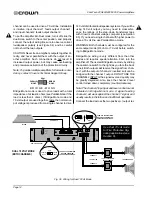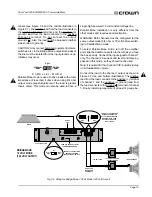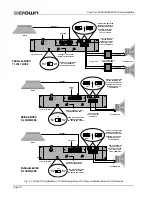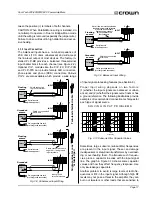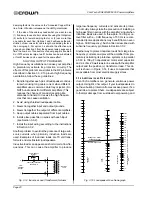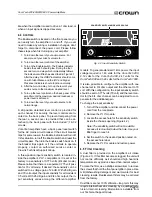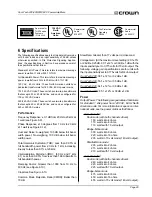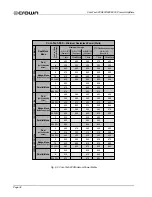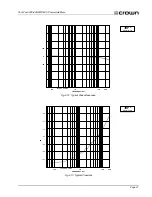
Page 26
Com-Tech 200/400/800/1600 Power Amplifiers
5 Technical Information
5.1 Overview
Com-Tech amplifiers incorporate several new techno-
logical advancements including real-time computer
simulation, low-stress output stages, an advanced
heat sink embodiment and the Programmable Input
Processor (
P.I.P.) expansion system.
Custom circuitry is incorporated to limit temperature
and current to safe levels making it highly reliable and
tolerant of faults. Unlike many lesser amplifiers, it can
operate at its voltage and current limits without self-de-
structing.
Real-time computer simulation is used to create an
analogue of the junction temperature of the output
transistors (hereafter referred to as the output de-
vices). Current is limited only when the device tem-
perature becomes excessive (and by the minimum
amount required). This patented approach called Out-
put Device Emulation Protection (or
ODEP) maximizes
the available output power and protects against over-
heating—the major cause of device failure.
The amplifier is protected from all common hazards
that plague high-power amplifiers, including shorted,
open or mismatched loads; overloaded power sup-
plies, excessive temperature and chain-destruction
phenomenon; input overload, high-frequency blow-
ups, internal faults, and input and output DC.
The four-quadrant topology used in a
Com-Tech
amplifier’s output stages is called the
grounded
bridge. This patented topology makes full use of the
power supply providing peak-to-peak voltages to the
load that are twice the voltage seen by the output de-
vices (see Figure 5.1).
As its name suggests, the
grounded bridge topology
is referenced to ground. Composite devices are con-
structed to function as gigantic NPN and PNP devices
to handle currents which exceed the limits of available
devices. Each output stage has two composite NPN
devices and two composite PNP devices.
The devices connected to the load are referred to as
“high-side NPN and PNP” and the devices connected
to ground are referred to as “low-side NPN and PNP.”
Positive current is delivered to the load by increasing
conductance simultaneously in the high-side NPN and
low-side PNP stage, while synchronously decreasing
conductance of the high-side PNP and low-side NPN.
The two channels may be used together to double the
voltage (Bridge-Mono) or current (Parallel-Mono) pre-
sented to the load. This feature gives you flexibility to
maximize power available to the load.
A wide bandwidth, multiloop design is used for state-
of-the-art compensation. This produces ideal behavior
and results in ultra-low distortion values.
Aluminum extrusions have been widely used for heat
sinks in power amplifiers due to their low cost and rea-
sonable performance. However, measured on a watts
per pound or watts per volume basis, the extrusion
technology doesn’t perform nearly as well as the heat
sink technology developed for
Com-Tech amplifiers.
Our heat sinks are fabricated from custom convoluted
fin stock that provides an extremely high ratio of area
to volume, or area to weight. All power devices are
mounted directly to massive heat spreaders that are
electrically at the Vcc potential. Electrifying the heat
spreaders improves thermal performance by eliminat-
ing the insulating interface underneath each power de-
vice. The chassis itself is used as part of the thermal
circuit to maximize utilization of the available cooling
resources.
5.2 Circuit Theory
Each channel is powered by its own power transformer
winding. Both channels share a common low-voltage
supply. The secondary output of T100 is full-wave rec-
tified by D109 and is filtered by a large computer
grade capacitor. A thermal switch embedded in the
power transformer protects it from overheating.
The low-voltage winding of the transformer is rectified
by diodes D1, D2, D3 and D4 to generate an unregu-
lated 24 volts. Monolithic regulators U1 and U2 provide
a regulated ±15 volts.
5.2.1 Dual Operation
For simplicity, the discussion of Dual operation will re-
fer to one channel only. Mono operation will be dis-
cussed in Sections 5.2.2 and 5.2.3.
Please refer to the block diagram in Figure 5.1 and the
schematics provided at the back of this manual.
The signal at the
P.I.P. barrier block passes directly
into the balanced input stage (U104-A). The balanced
input stage causes balanced to single-ended conver-
sion using a difference amplifier. Next the variable gain
stage (U104-B) amplifies or attenuates the signal. The
gain of this stage is set by the position of the input sen-



